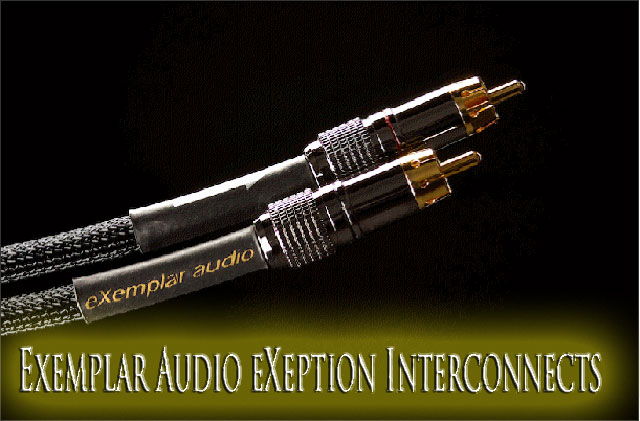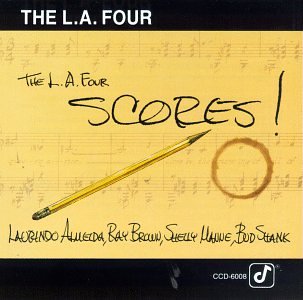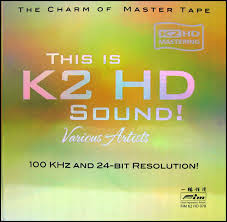Exemplar Audio eXeption Interconnects

 It is with some satisfaction that I can say that the Exemplar Audio eXeption interconnects ($349/meter RCA, $399/meter XLR) are outstanding, especially the balanced/XLR cables. As you can see, there is really nothing that looks exceptional about these cables. Hopefully there will be white papers forthcoming from Exemplar’s John Tucker that might tell us how these cables got to be so… exemplary (sorry). Personally, I know little other than how pleased I am with the sound, but this is what Tucker himself suggested I say.
It is with some satisfaction that I can say that the Exemplar Audio eXeption interconnects ($349/meter RCA, $399/meter XLR) are outstanding, especially the balanced/XLR cables. As you can see, there is really nothing that looks exceptional about these cables. Hopefully there will be white papers forthcoming from Exemplar’s John Tucker that might tell us how these cables got to be so… exemplary (sorry). Personally, I know little other than how pleased I am with the sound, but this is what Tucker himself suggested I say.
“We’ve listened to input from our clients and decided to add a new line of cables to the Exception series of products. Like our Exception electronics, the Exception line of cables has been designed to offer the best possible performance at a real world price.
After several years of development and trying many different types of wire, configurations and combinations of elements we’ve been able to achieve that goal. The Exception line of cables employs good quality parts and wire and our unique RFI/EMI suppression technology to provide performance competing with some of the best cables available today at a fraction of the cost.”
I should note that despite my initial impressions with the RCA terminated cables, I got two pair of the XLR/balanced cables. XLR/Balanced cables are not available with my reference, the High Fidelity cables. Initially, I thought I would mostly stress the RCA/single-ended cables, but the balanced cables proved clearly superior, at least in my system.
Setup
My setup has changed greatly in the last six months. With the great help of Miguel Alvarez of Tripoint Audio, I have greatly improved the grounding of my B.M.C. M2 monoblocks and B.M.C. MCCI phono stage. We put in Cardas solid copper binding posts with the power supplies, circuit boards, and transformers directly grounded to the Tripoint Troy Signature grounding system and using Tripoint Thor SE grounding cables to do so. Secondly, I now have Star Sound Tech. Rhythm platforms under my amps and a three-shelf rack for my components. I have previously reviewed all of these.
My reference cables are High Fidelity Ultimate Reference, which uses what they call “Magnetic Conduction.” This aligns the North Poles of magnets to ease the flow of signals through to the speakers and back. They take a lengthy time to break in or more correctly to establish a magnetic path through the system. But this means that when substituting other cables the effects of this “path” may remain for some time. Since most cables do improve with the first hundred or so hours, a reviewer may unwarrantedly conclude that new cables may be the equal of the High Fidelity cables. Or it may be even more complicated as the new cables break in may be where the HFC effect is moderating their improvement with breaking in. I am assuming that the HFC effect is less than 24 hours and that the full break-in takes longer. Two pairs of Exemplar eXeptions had five days on my burner, and about a week and a half use in listening to music with them. The Exemplar eXeptions take a very long time reaching their best and each day, I was welcomed with even better sound. Adding the XLR versions later entailed getting them broken in also.
Listening Sessions
 I used a number of cuts in my evaluations that probably reflect my age and tastes. One was Clark Terry’s Live At The Village Gate [Chesky Records, JD49]. Paquito D’Rivera joins the band in playing, Silly Samba and the place rocks. A second was the L.A. Four’s Scores! [Concord Jazz, CJ-8], which is an outdoor recording and thus no recording venue reflections, but substantial wind noise in the last several cuts. A third is Diana Krall’s “S’Wonderful” on The Look of Love [Verve Records SACD 314 589 597-2], which is now on my hard drive in DSD and played in double DSD. It was well recorded, but with the Thor SEs, the location of the orchestra is evident somewhat behind her. One can hear the ambiance of the recording venue. Also the full human character of her voice strikes you as having her eight feet in front of you.
I used a number of cuts in my evaluations that probably reflect my age and tastes. One was Clark Terry’s Live At The Village Gate [Chesky Records, JD49]. Paquito D’Rivera joins the band in playing, Silly Samba and the place rocks. A second was the L.A. Four’s Scores! [Concord Jazz, CJ-8], which is an outdoor recording and thus no recording venue reflections, but substantial wind noise in the last several cuts. A third is Diana Krall’s “S’Wonderful” on The Look of Love [Verve Records SACD 314 589 597-2], which is now on my hard drive in DSD and played in double DSD. It was well recorded, but with the Thor SEs, the location of the orchestra is evident somewhat behind her. One can hear the ambiance of the recording venue. Also the full human character of her voice strikes you as having her eight feet in front of you.
 Other cuts include: Sinatra At The Sands [Vicy 94366 Japan SHM]. There is an audience and a big orchestra, plus Sinatra and Basie present. I particularly like the piece “One for My Baby.” The clear sense of being in the room and the precise locations of Sinatra, Basie, the band, and the audience give the thrill of being there. This happens as well as with Amerset’s Swan Lake Duo selection on the K2 sampler This Is K2 HD Sound UD! [FIM K2 HD 078], again lends an openness and clarity to the music. Finally, there is Paul Simon’s Songwriter [Sony Legacy B005KLNOLA]. The first cut is “The Sound of Silence” done in Webster Hall live. He is alone with his guitar. This is the most real sounding cut of the album, including all the young men making asses of themselves.
Other cuts include: Sinatra At The Sands [Vicy 94366 Japan SHM]. There is an audience and a big orchestra, plus Sinatra and Basie present. I particularly like the piece “One for My Baby.” The clear sense of being in the room and the precise locations of Sinatra, Basie, the band, and the audience give the thrill of being there. This happens as well as with Amerset’s Swan Lake Duo selection on the K2 sampler This Is K2 HD Sound UD! [FIM K2 HD 078], again lends an openness and clarity to the music. Finally, there is Paul Simon’s Songwriter [Sony Legacy B005KLNOLA]. The first cut is “The Sound of Silence” done in Webster Hall live. He is alone with his guitar. This is the most real sounding cut of the album, including all the young men making asses of themselves.
The last two years I have broadened my focus to listening for realism of the performance and feeling the emotion of the musicians. This revolves around the tumbrel realism of the instruments, great soundstage precision or focus, decay of notes, ambiance of the recording studio or hall, a sense of being encompassed by the recording, and getting greatly involved in the performance and the musicians’ enthusiasm.
As I said earlier, Terry and D’Rivera’s Silly Samba reeks with performer enthusiasm as Terry notes afterwards, saying, “That was great!” The Exemplar eXception XLRs involve me in this enthusiasm while the RCAs did not. Diana Krall’s “S’Wonderful” gave a wonderful sense of the soundstage and her placement as well as that of the band. One really feels as thou you are in the studio. This was not evident on the CD. Realism is once again notable on the entire L.A. Four’s Scores! recording. One can totally sense being at an outdoor performance. Here I did not hear much difference between balance and single-ended cables. Both gave the impression of being there.
The Sinatra and the Basie band recording is best on the original vinyl, but on the SHM Japanese release the sense of being in the old Sands theater dining area is right on as I remember it. This is very well recorded. I have always loved Amerset’s Swan Lake recording, especially the one remastered by Winton Ma on FIM. When the timbre of the instruments is fully captured, it is a marvelous recording and makes me wish I had been there. Again the quiet of the XLRs and the precision of placement lends greater joy.
Conclusion
I am fortunate in having with the Koda K10 and the B.M.C. M2 amps the ability to go totally from single-ended to balanced cables and to do so quickly. Obviously, I prefer the XLR eXceptions to the RCAs. But many may not find the thrilling glory with realism or the added expense of the XLRs to be worth it, especially if their components do not provide XLR inputs or outputs. Also, I am mindful that I have many things in my system that may allow me to hear subtle differences that others may not hear. Overall, I would strongly recommend that you seek a trial hearing of these cables. If I decide to keep my second system, I will be getting these interconnects as well as the Exemplar speaker wires.


norm luttbeg
Specifications:
$349 @ pair RCA 1 meter plus $60/ additional meter
$399 @ pair XLR 1 meter plus $60/ additional meter
Exemplar Audio LLC
2909 95th Drive SE
Lake Stevens, WA 98258
Phone: (425) 334-4733
Website: www.exemplaraudio.com/portalinterconne.html
Email: sales@exemplaraudio.com
Stereo Times Masthead
Publisher/Founder
Clement Perry
Editor
Dave Thomas
Senior Editors
Frank Alles, Mike Girardi, Russell Lichter, Terry London, Moreno Mitchell, Paul Szabady, Bill Wells, Mike Wright, and Stephen Yan,
Current Contributors
David Abramson, Tim Barrall, Dave Allison, Ron Cook, Lewis Dardick, John Hoffman, Dan Secula, Don Shaulis, Greg Simmons, Eric Teh, Greg Voth, Richard Willie, Ed Van Winkle, Rob Dockery, Richard Doran, and Daveed Turek
Site Management Clement Perry
Ad Designer: Martin Perry






Be the first to comment on: Exemplar Audio eXeption Interconnects